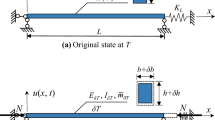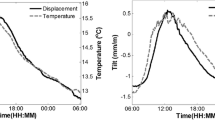Abstract
Many studies have indicated that structural strain will be significantly influenced by temperature variations, and a good understanding of the effect of temperature on structural strain is essential. A structural health monitoring system has been installed in a typical Tibetan timber building to measure the structural strains and ambient temperature since 2012. This paper presents the correlation between temperature and strain data from the monitored structure. A method combining singular spectrum analysis and polynomial regression is proposed for modeling the temperature induced strains in the structure. Singular spectrum analysis is applied to smooth the temperature data, and the correlation between the resulting temperature time series and the measured strains is obtained by polynomial regression. Parameters of the singular spectrum analysis and the regression model are selected to have the least regression error. Results show that the proposed method has both good reproduction and prediction capabilities for temperature induced strains, and that the method is accurate and effective for eliminating the effect of temperature from the measured strain. A standardized Novelty Index based on the residual strain is also used for the condition assessment of the structure.
Similar content being viewed by others
References
Basseville M, Bourquin F, Mevel L, Nasser H and Treyssede F (2010), “Handling the Temperature Effect in Vibration Monitoring: Two Subspace-Based Analytical Approaches,” Journal of Engineering Mechanics, 136: 367–378.
Bring J (1996), “A Geometric Approach to Compare Variables in a Regression Model,” The American Statistician, 50: 57–62.
Dai L, Yang N, Zhang L, Yang QS and SS Law (2016), “Monitoring Crowd Load Effect on Typical Ancient Tibetan Building,” Stru ctural Control and Health Monitoring, 23: 998–1014.
Deng Y, Ding YL and Li AQ (2010), “Structural Condition Assessment of Long-Span Suspension Bridges Using Long-Term Monitoring Data,” Earthquake Engineering and Engineering Vibration, 9:123–131.
Deraemaeker A, Reynders E, Roeck G De and Kullaa J (2008), “Vibration-Based Structural Health Monitoring Using Output-Only Measurements under Changing Environment,” Mechanical Systems and Signal Processing, 22: 34–56.
Ding YL and Li AQ (2011), “Temperature-Induced Variations of Measured Modal Frequencies of Steel Box Girder for a Long-Span Suspension Bridge,” International Journal of Steel Structures, 11: 145–155.
Fridley KJ, Tang RC and Soltis LA (1992), “Hygrothermal Effects on Mechanical Properties of Lumber,” Journal of Structural Engineering, 118: 567–581.
Fugate ML, Sohn H and Farrar CR (2001), “Vibration-Based Damage Detection Using Statistical Process Control,” Mechanical Systems and Signal Processing, 15: 707–721.
Golyandina N, Nekrutkin V and Zhigljavsky AA (2001), Analysis of Time Series Structure—SSA and Related Techniques, Chapman and Hall/CRC: New York.
Hua XG, Ni YQ, Ko JM, ASCEF and Wong KY (2007), “Modeling of Temperature–Frequency Correlation Using Combined Principal Component Analysis and Support Vector Regression Technique,” Journal of Computing in Civil Engineering, 21:122–135.
Isaac FA, Marios KC and Jacob EA (2015), “Regression Models for Structural Health Monitoring of Welded Bridge Joints Based on Temperature, Traffic and Strain Measurements,” Structural Health Monitoring, 14: 648–662.
Kim JT, Park JH and Lee BJ (2007), “Vibration-Based Damage Monitoring in Model Plate-Girder Bridges under Uncertain Temperature Conditions,” Engineering Structures, 29: 1354–1365.
Kullaa J (2009), “Eliminating Environmental or Operational Influences in Structural Health Monitoring Using the Missing Data Analysis,” Journal of Intelligent Material Systems and Structures, 20: 1381–1390.
Li P (2009), “Mechanical Mechanism of Beam-Column Joints in Wooden Frame of Tibetan Ancient Architecture,” Thesis of Beijing Jiaotong University, Beijing.
Liu CY, John T and De wolf (2007), “Effect of Temperature on Modal Variability of a Curved Concrete Bridge under Ambient Loads,” Journal of Structural Engineering, 133: 1742–1751.
Liu K, SS Law, Xia Y and Zhu XQ (2014), “Singular Spectrum Analysis for Enhancing the Sensitivity in Structural Damage Detection,” Journal of Sound and Vibration, 333: 392–417.
Loh Mao CH, Huang JR and Pan TC (2011), “System Identification and Damage Evaluation of Degrading Hysteresis of Reinforced Concrete Frames,” Earthquake Engineering and Structural Dynamics, 40: 623–640.
Lucas JM (1982), “Combined Shewhart-CUSUM Quality Control Schemes,” Journal of Quality Control, 14: 51–59.
Moaveni and Behmanesh I (2012), “Effects of Changing Ambient Temperature on Finite Element Model Updating of the Dowling Hall Footbridge,” Engineering Structures, 43: 58–68.
Ni YQ, Hua XG, Fan KQ and Ko JM (2012), “Correlating Modal Properties with Temperature Using Long-Term Monitoring Data and Support Vector Machine Technique,” Engineering Structures, 27: 1762–1773.
Ni YQ, Xia Y, Liao WY and Ko JM (2009), “Technology Innovation in Developing the Structural Health Monitoring System for Guangzhou New TV Tower,” Structural Control and Health Monitoring, 16: 73–98.
Peeter B and Roeck G De (2001), “One-Year Monitoring of the Z24-Bridge: Environmental Effects Versus Damage Events,” Earthquake Engineering and Structural Dynamics, 20: 149–171.
Qi Xia, Yu Yao Cheng, Jian Zhang and FengQi Zhu (2017), “In-Service Condition Assessment of a Long-Span Suspension Bridge Using Temperature-Induced Strain Data,” Journal of Bridge Engineering, 22: 1–11.
S M O’ Connor, Y Zhang, J P Lynch and MM Ettouney (2017),“Long-Term Performance Assessment of the Telegraph Road Bridge Using a Permanent Wireless Monitoring System and Automated Statistical Process Control Analytics,” Structure and infrastructure engineering, 13: 604–624.
Sheng Yu and Jinping Ou (2017), “Structural Health Monitoring and Model Updating of Aizhai Suspension Bridge,” Journal of Aerospace Engineering, 30: 1–15.
Sohn H (1999), “An Experimental Study of Temperature Effect on Modal Parameters of the Alamosa Canyon Bridge,” Earthquake Engineering and Structural Dynamics, 28: 879–897.
Vanlanduit S, Parloo E, Cauberghe B, Guillaume P and Verboven P (2005), “A Robust Singular Value Decomposition for Damage Detection under Changing Operating Conditions and Structural Uncertainties,” Journal of Sound and Vibration, 284: 1033–1050.
Wang J, Yang N and Yang QS (2010), “Technology of Monitoring and Testing for Ancient Timber Structures,” 12th International Conference on Inspection, Appraisal, Repairs & Maintenance of Structures, Yantai, China.
Xia Y, Chen B, Weng S, Ni YQ and Xu YL (2012), “Temperature Effect on Vibration Properties of Civil Structures: a Literature Review and Case Study,” Journal of Civil Structural Health Monitoring, 2: 29–46.
Xin W, Ji W, Chao L, Senzhang W and Wensheng Niu (2016), “A Hybrid Model Based on Singular Spectrum Analysis and Support Vector Machines Regression for Failure Time Series Prediction,” Quality and Reliability Engineering International, 32: 2717–2738.
Yan A M, Kerschen G, Boe P De and Golinval JC (2005), “Structural Damage Diagnosis under Varying Environmental Conditons-Part I: a Linear Analysis,” Mechanical Systems and Signal Processing, 19: 647–864.
Yuen KV and Kuok SC (2010), “Modeling of Environmental Influence in Structural Health Assessment for Reinforced Concrete Buildings,” Earthquake Engineering and Engineering Vibration, 9: 295–306.
Zhang DY, Bao YQ, Li H and Ou JP (2012), “Investigation of Temperature Effects on Modal Parameters of the China National Aquatics Center,” Advances in Structural Engineering, 15: 1139–1153.
Zhou HF, Ni YQ, ASCE M, Ko JM and ASCE F (2011), “Eliminating Temperature Effect in Vibration-Based Structural Damage Detection,” Journal of Engineering Mechanics, 137: 785–796.
Author information
Authors and Affiliations
Corresponding author
Additional information
Supported by: National Natural Science Foundation of China for Excellent Young Scholars under Grant No. 51422801, National Natural Science Foundation of China under Key Program 51338001, Beijing Natural Science Foundation of China under Key Program: 8151003
Rights and permissions
About this article
Cite this article
Bai, X., Yang, N. & Yang, Q. Temperature effect on the structural strains of an ancient Tibetan building based on long-term monitoring data. Earthq. Eng. Eng. Vib. 17, 641–657 (2018). https://doi.org/10.1007/s11803-018-0437-x
Received:
Accepted:
Published:
Issue Date:
DOI: https://doi.org/10.1007/s11803-018-0437-x




